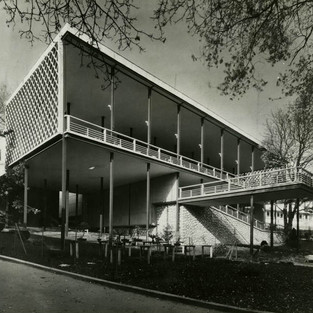Junzo Sakakura - Japanese. Architect. Innovator. Poet.
- tipsy modernist
- Jun 24, 2020
- 3 min read
Updated: Apr 16, 2024

The Fountainhead was full of sh*t. Contrary to the book and popular mythology, large scale architectural projects are never the product of a single hand, but of many hands. Every famous architect, whether Le Corbusier, or FLW, all used teams of people toiling away (usually unpaid) in their studios to crank out the actual drawings while the "master" was rustling up clients (and perhaps seducing their wives while he was at it.) Junzo Sakakura was one of those unsung heroes. He studied architecture and art history at Tokyo Imperial University, graduating in 1927. By 1930 he had made his way to Paris, and Le Corbusier’s studio. He worked there for seven years (paid sporadically if at all) (1), eventually becoming the studio chief. Junzo returned to Japan where he established a lengthy career as one of Japan’s first modernist architects. Although his work is clearly influenced by Le Corbusier, it contains many elements of classic Japanese design such as the use of natural materials and traditional Japanese craftsmanship. Like Charlotte Perriand, (with whom he also worked in Corb's studio,) he was interested in creating a form of modernism that incorporated local, traditional building techniques and humble materials.

He started his career with the Japanese pavilion in Paris in 1937. The committee had initially
selected Kunio Maekawa for the project but Junzo was selected because of his experience working in France. In the Japanese Pavilion for the Paris Expo, you can see the slender pilotti one associates with Le Corbusier, but the brise soleil clearly looks inspired by traditional woven Japanese wrapping, such as seen in the cult book "How to Wrap Five Eggs" by Hideyuki Oka, or even contemporary projects by Shigeru Ban.
Japanese Pavilion,Junzo Sakakura Rice cakes Centre Pompidou Shigeru Ban
He went on to design the Museum of Modern Art in Kamakura, the first public museum of modern art in Japan in 1951 and in the late fifties he worked again with Le Corbusier on his Museum of Western Art in Tokyo, along with Kunio Maekawa and Takamasa Yoshizaka (both of whom who had also worked in Corbusier's office). He is most well known for his design of several railway stations in Tokyo as well as the Takashimaya department store.


He worked extensively with Charlotte Perriand on projects in Japan including furniture, interiors and displays for the Takashimaya department store, and also the Air France offices in Tokyo. They first met while working in Le Corbusier’s office and when he was approached by a Japanese folk-art movement dedicated to preserving traditional crafts to create a range of modern designs for export (utilizing traditional Japanese craftsmanship), he suggested Charlotte. He and Perriand produced many similar pieces of rustic wooden furniture utilizing woven rush,rattan, and bamboo. The chair above was Sakakura's entry for the MoMA competition for Low-Cost Furniture Design. Designed to be fabricated almost entirely from sustainable and inexpensive bamboo, it is strikingly similar to Le Corbusier's Kangourou chair circa 1955 designed for Chandigarh. One wonders if Sakakura may have had a hand in its design as well.
Japanese modernism is a fascinating and critical period, yet we hear very little about it in the west, as these architects were not considered part of the "modernist canon" by cultural gatekeepers. The simplicity, austerity and sincerity that are all hallmarks of traditional Japanese design created a unique hybrid of modernism very different from the soaring and brutal direction that modernism evolved into in the west. Junzo Sakakura, Kunio Maekawa and Takamasa Yoshizaka brought modernism to Japan through their work, influencing future generations of architects such as Shigeru Ban, Yoshiru Taniguchi and Ryue Nishizawa and Kazuyo Sejima of Sanaa, who are in turn inspiring architects all over the world today.
Japanese Pavilion, 1937 New Museum 2007 Brooklyn Birds Nest stadium 2007 Bejing
Thirsty for More? Don't forget to check out the accompanying cocktail recipe for the
Sakura Martini here
Sources
McLeod, Mary Charlotte Perriand: An Art of Living.Abrahms 2003
Oka,Hideyuki , How to Wrap Five Eggs Weatherhill, 1967
Cao, Yi Junzo Sakakura: Architecture for Humans, Urban Mishmash 2017
Notes
(1) McLeod. p.36






















Comments